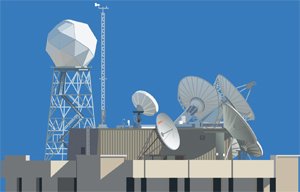 |
Director's NoteHank Revercomb |
“Suomi NPP” is the first Earth science or weather satellite named for an individual. This name is such a befitting honor for the Father of Meteorological Satellites that it sent shivers down my spine when Tom Actor notified me that the official announcement had been made at the American Meteorological Society meeting in New Orleans on 24 January.

Verner Suomi, with Explorer 7 and the Suomi NPP satellite and a “Blue Marble” image of the Earth, taken from the Visible Infrared Imager Radiometer Suite instrument aboard NASA's most recently launched Earth-observing satellite, Suomi NPP. This composite image of Earth uses a number of swaths of the Earth's surface.
Image Credits: NASA/NOAA/GSFC/Suomi NPP/VIIRS/Norman Kuring and UW Communications.
The NPP spacecraft introduces a fundamentally new complement of instruments for operational weather and climate applications. Renaming it for our own Professor Verner E. Suomi, who not only co-founded the Center but continued to inspire us right up to his death in 1995, is a perfect tribute to the pioneer that championed the importance of the weather satellite to NASA, NOAA, and around the world.
The connection between NPP capabilities and Vern’s legacy is outlined below.
- In 1959, Verner Suomi’s instrument on Explorer VII made the first measurements of the Earth from space and defined the radiation balance that establishes our climate. NPP contains the Clouds and Earth's Radiant Energy System (CERES) that continues the climate record initiated by that first experiment. SSEC is currently working to develop an even more advanced climate observatory.
- The Advanced Technology Satellites (ATS) launched into geostationary orbit in 1965 and 1966 carried the spin-scan camera conceptualized by Suomi to make movies from which cloud motion winds could be measured. The Man-computer Interactive Data Access System (McIDAS) at SSEC, the first serious computer system for processing satellite data, was motivated by Vern’s drive to provide wind measurements for improving weather forecasts. The Visible Infrared Imager Radiometer Suite (VIIRS) on NPP will, among a wide array of products, add to the record of atmospheric winds started by ATS by observing cloud motions between consecutive polar orbits at high latitudes.
- Suomi was also a pioneer in sounding temperature and water vapor profiles of the atmosphere using infrared emitted radiation. In 1980, his efforts were realized with the launch of the VISSR Atmospheric Sounder (VAS), the first sounder to fly in geosynchronous orbit. NPP also includes the Cross-track Infrared Sounder (CrIS) IR sounder that uses much higher spectral resolution to advance the capabilities of heritage sounding instruments. Much of the development for CrIS was done at UW-Madison, SSEC. NPP also carries the Advanced Technology Microwave Sounder (ATMS) that uses microwave emissions from the Earth to sound the atmosphere.
A fifth instrument on NPP, the Ozone Mapper Profiler Suite (OMPS), will extend the 25-plus year record of total-ozone and ozone-profiles and monitor aerosol properties. Vern would be pleased by this too.
We have years of interesting work ahead to make sure that the data, results, and impact of this new satellite live up to its new name.

